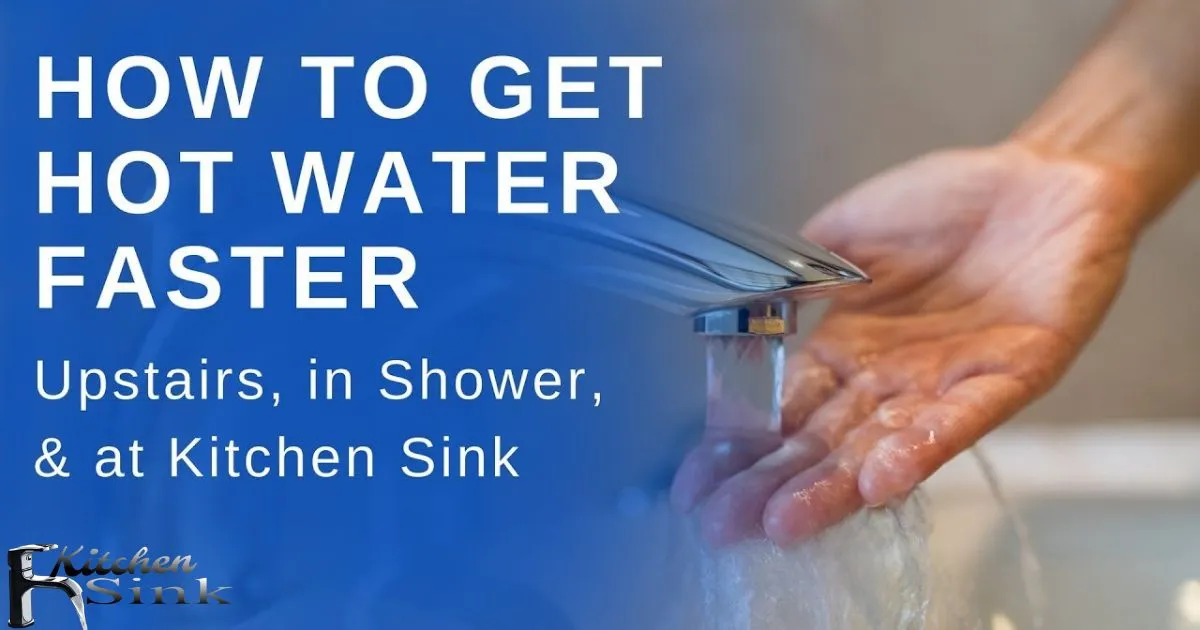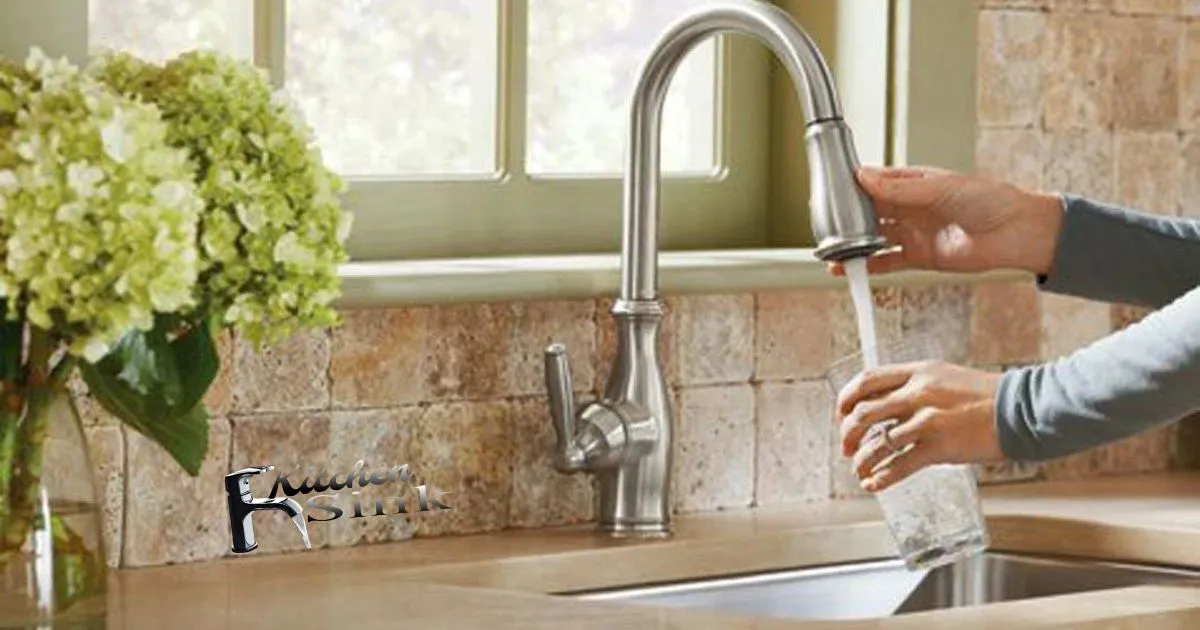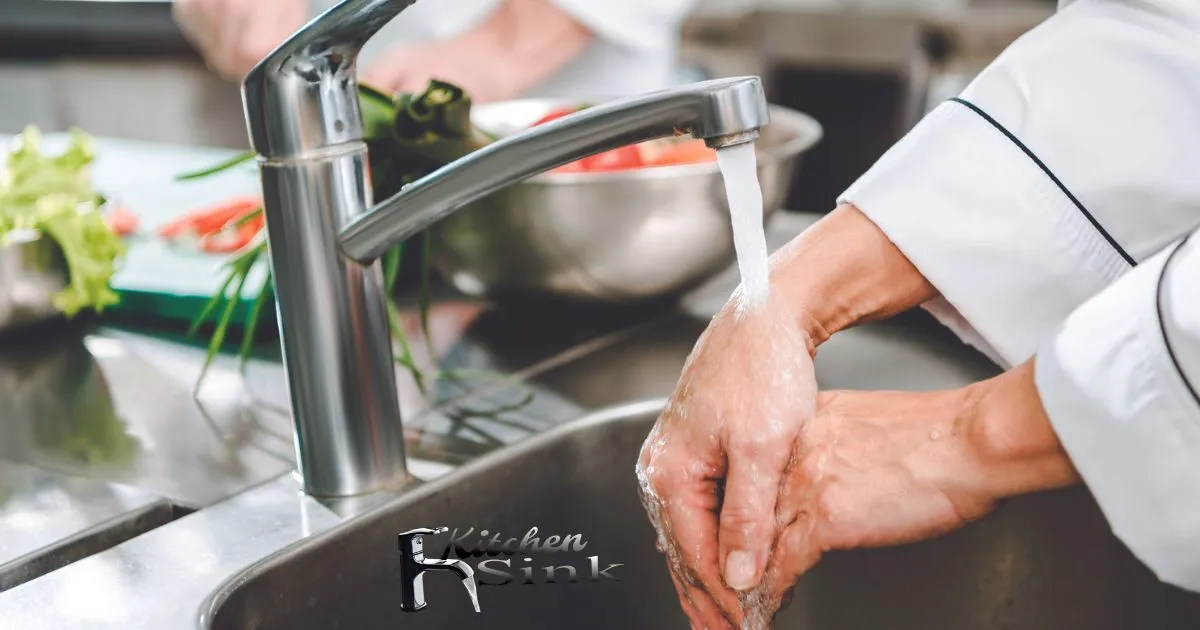Getting hot water faster at the kitchen sink is about increasing the flow of hot water to the faucet so you don’t have to wait as long when turning it on. There are several methods to accomplish this, from simple adjustments to more complex plumbing solutions. The goal is to reduce the time wasted waiting for the water to heat up to a usable temperature.
How To Get Hot Water Faster At Kitchen Sink? is a common question for homeowners. Waiting at the sink for water to get hot enough to use can be frustrating and time consuming. Getting hot water quickly is convenient and saves water that would otherwise go down the drain while waiting.
Speeding up hot water delivery to the kitchen faucet involves understanding your home’s plumbing system. Simple fixes like insulating pipes or installing a hot water recirculating pump can drastically cut down on wait times. Identifying where bottlenecks occur and targeting improvements specifically to address them is key for this DIY project.
Why is my kitchen sink hot water slow?
The most common reasons for low hot water pressure specifically in the kitchen sink are buildup and clogging in the hot water line branching to the kitchen, issues with the hot water shut off valve under the sink being closed or clogged, or problems with the hot water heater itself such as sediment buildup in the tank blocking water flow. Less common causes could be galvanized piping corroding and restricting flow to the kitchen.
causes low kitchen sink hot water pressure
Low kitchen sink hot water pressure is usually caused by some type of blockage or restriction of flow in the hot water lines leading to and supplying the faucet. This could be mineral deposits inside pipes, debris caught in valves, closed valves, failing water heater components, or corrosion of galvanized steel pipes.
Do some faucets have faster hot water?
Yes, some faucet models and brands are designed and engineered to allow faster hot water flow. Features like larger waterways, fewer parts, or integrated supply lines can reduce restrictions and allow more hot water flow volume through the faucet. High-end kitchen faucets emphasize performance.
Does pipe size affect kitchen sink hot water speed?
Yes, the size of water supply pipes and valves makes a difference in potential hot water flow rate. Larger diameter piping allows more water to flow through. Upgrading old 1/2″ pipes to 3/4″ or 1″ lines increases flow capacity. Kitchen Sink Without Replacing Countertop Faucet components like valves and supply hoses can also restrict flow if too small.
Can I fix low kitchen sink hot water pressure myself?
It’s possible to fix low kitchen hot water pressure yourself in some cases, such as clearing valve or aerator clogs. But issues involving piping in walls, water heater problems, or galvanized pipe corrosion usually require a professional plumber’s skills, tools, code knowledge, and experience for proper diagnosis and repairs.
How can I get hot water to my kitchen sink faster?
There are several methods to speed up hot water delivery to the kitchen sink. Insulating the hot water pipes leading to the kitchen can help retain heat so less time is needed to reheat the water. Installing a hot water recirculating pump will circulate hot water through the pipes back to the water heater so hot water is always near the kitchen sink ready to flow.
Replacing old galvanized pipes with newer copper pipes can also accelerate hot water since copper transfers heat better. Finally, tankless water heaters provide instant continuous hot water on demand so no wait is needed for hot water to reach the faucet.
insulate pipes under the kitchen sink
Insulating the hot and cold water pipes under the kitchen sink can help hot water get to the faucet faster. Pipe insulation prevents heat loss so hot water stays hotter as it travels through the pipes. The insulation also keeps the cold water cooler so it doesn’t absorb as much heat from the hot water pipe.
This maintains the maximum temperature difference to deliver hot water faster to the faucet. Insulation is inexpensive and easy to install by wrapping the foam or fiberglass insulation around the pipes and sealing with tape. This simple upgrade cuts the wait time for hot water.
Will a hot water recirculating pump accelerate kitchen sink hot water?
Installing a dedicated hot water recirculating pump and return line is an effective way to reduce wait times for hot water at the kitchen faucet. The pump circulates hot water from the water heater through the hot water pipes and back to the heater via a dedicated return line.
This keeps hot water primed in the pipes ready to flow instantly when the faucet is turned on. The pump runs on a timer or thermostat to maintain the hot water loop while conserving energy. For fastest hot water, the return line can be plumbed directly back from the kitchen faucet. This provides instantaneous hot water because the circulation keeps hot water right at the faucet.
install a dedicated hot water line to my kitchen sink
Running a separate dedicated hot water line directly from the water heater to the kitchen sink is the best way to get instant hot water. This smaller diameter PEX pipe has no cold water to flush out before hot water reaches the faucet. The shorter, direct route allows hot water to arrive in seconds.
Retrofitting a dedicated line can require opening walls for new piping. If this isn’t feasible, insulating the existing hot water line, adding a recirculation system, or replacing old galvanized pipes can still accelerate hot water delivery.
fastest way to get hot water to my kitchen sink
The fastest way to get hot water is by installing an instant tankless water heater near the kitchen sink. Tankless heaters provide unlimited hot water on demand without waiting for water to heat like in tank water heaters. For immediate hot water, a whole house tankless unit can be located close to the kitchen sink to minimize the pipe distance hot water must travel.
A point-of-use tankless water heater mounts directly under the kitchen sink for the fastest possible hot water. Turning on the faucet triggers the instant tankless heater to deliver a constant flow of hot water in seconds. This is the fastest way to get hot water to the kitchen sink.
What are signs of insufficient hot water at kitchen sink?
Signs of insufficient hot water at the kitchen sink include very low flow or pressure from the hot water handle, significantly slower hot water flow compared to the cold water, and having to wait a very long time for hot water to start flowing. This indicates an issue specific to the hot water supply to the kitchen faucet.
long wait for hot water at kitchen sink normal
A moderately long wait for hot water at the kitchen sink can be normal, especially if the sink is far from the hot water heater. But an excessively long wait over 30-60 seconds likely indicates a problem reducing hot water flow somewhere in the line specifically affecting the kitchen.
Do some faucets provide hot water faster to kitchen sink?
Yes, some faucet models and supply line setups provide hot water faster by reducing the amount of water in the supply pipes between the heater and faucet. Shorter, straighter supply lines also deliver hot water faster. Replacing an old faucet can potentially provide faster hot water.
Could sediment in pipes or heater reduce kitchen sink hot water flow?
Yes, heavy sediment buildup and mineral deposits inside the hot water pipes, connectors, and valves leading to the kitchen faucet can significantly reduce water flow. Sediment and scale inside the hot water heater tank can also reduce hot water pressure throughout the home.
Does very low kitchen sink hot water pressure indicate a major problem?
Very low hot water pressure isolated only at the kitchen sink likely indicates a localized clog or buildup rather than a whole-house or major plumbing issue. But it still requires diagnosis and repair, and the specific source of blockage may not be easily accessible or repairable without professional help.
How much does it cost to speed up kitchen sink hot water?
Insulating pipes and installing heat tape are relatively inexpensive options to help speed hot water delivery, with insulation costing around $0.50-$1 per linear foot and heat tape $6-$10 per linear foot. For a typical kitchen sink with 20 feet of pipe from the water heater, insulation would cost $10-$20 and heat tape $120-$200 plus installation.
More expensive options are installing a recirculating pump, around $150-$500 for the pump plus $200-$500 for installation, or installing a dedicated hot water line which can cost $10-$20 per linear foot for materials and labor.
insulation and heat tape affordable kitchen sink hot water upgrades
Insulating pipes and installing heat tape are very affordable upgrades to accelerate hot water to the kitchen sink. Insulation costs less than $1 per linear foot and heat tape less than $10 per foot. For a typical 20 foot kitchen sink pipe run, insulation would be $10-$20 and heat tape $120-$200 in materials. When factoring in ease of DIY installation, these are cost-effective ways to reduce wait times for hot water.
hot water recirculating pump pricey to accelerate kitchen sink hot water
A hot water recirculating pump can cost $150-$500 for the pump itself, plus $200-$500 or more for installation costs. This puts the total expense in the range of $350-$1000. While not inexpensive, the convenience of nearly instant hot water at faucets can make it worthwhile for some homeowners.
Operating costs are estimated around $30-$100 per year for the added pump electricity usage. Overall it is one of the pricier options for accelerating kitchen sink hot water delivery.
How expensive is it to install a dedicated hot water line for kitchen sink?
Installing a dedicated 3/8″ PEX hot water line from the water heater directly to the kitchen sink specifically for faster hot water is one of the more expensive options. PEX tubing costs around $0.50-$1 per linear foot, and hiring a plumber to install typically runs $50-$100 per hour.
For a kitchen with a water heater 20 feet away, the dedicated line could cost $10-$20 in tubing plus $100-$300 for 4-6 hours of plumber time. While very effective, the $150-$400 total makes it one of the more costly upgrades.
most budget friendly option for faster kitchen sink hot water
Of all the options to accelerate hot water delivery to the kitchen sink, insulating the pipes is typically the most budget friendly. Simple foam pipe insulation provides an effective barrier to minimize heat loss for very little cost, averaging just $0.50-$1 per linear foot of pipe.
Even without professional installation, total material cost to insulate a 20 foot kitchen sink hot water pipe would be only about $10-$20. For the money, pipe insulation provides significant bang for the buck.
What are the benefits of accelerating kitchen sink hot water?
Getting hot water to the kitchen sink faster provides several benefits. It saves time by eliminating the need to wait for hot water when washing dishes, preparing food, or doing other kitchen tasks requiring hot water.
This improved convenience makes kitchen activities more efficient. Faster hot water also reduces wasted water from running the tap while waiting for hot water to arrive. Finally, faster delivery of hot water can allow using lower water heater temperatures while still getting suitably hot water from the faucet.
faster kitchen sink hot water use less water
Yes, accelerating hot water to the kitchen sink reduces wasted water. Without a fast hot water system, people typically let the tap run for a while to get hot water, dumping cold water they don’t need down the drain while waiting. Recirculating hot water systems reuse this otherwise wasted cold water to bring hot water to the tap sooner. This cuts water waste and saves on water bills.
Accelerating kitchen sink hot water reduce energy bills?
Faster hot water can provide some energy savings in a couple ways. First, less water waste means less energy is used to heat the wasted water. Additionally, faster hot water allows adjusting the water heater to a lower temperature while still getting suitably hot water from faucets. This reduces standby losses from the hot water heater and saves energy. However, energy use of pumps in recirculating systems offsets savings somewhat.
hot water safety improved with a faster kitchen sink supply
Yes, faster hot water reduces the risk of scalding accidents. Without fast hot water, people may start using hot water at dangerously high temperatures to compensate for the long wait at the faucet. Quick hot water delivery allows providing adequate hot water at safer temperatures. Recirculation systems also maintain hot water pipes at safe temperatures by preventing cooling in long pipe runs.
daily conveniences come with speedier kitchen sink hot water
Faster hot water makes kitchen tasks like washing dishes, cleaning, and cooking more convenient by eliminating frustrating waits at the sink. This allows efficiently going from one hot water task to another without delays between activities. Quick hot water also makes activities like shaving at the sink or filling pots for cooking pasta simpler and easier. Overall, faster hot water saves time and frustration during common daily activities.
Frequently Asked Question
Will insulating pipes under the kitchen sink provide faster hot water?
Yes, insulating pipes can reduce heat loss allowing hot water to arrive at the faucet quicker.
Can installing a hot water recirculating pump accelerate kitchen sink hot water?
A recirculating pump that cycles water back to the heater will dramatically decrease wait times for hot water at the kitchen sink.
What is the benefit of a dedicated hot water line to the kitchen faucet?
A direct hot water supply line from the water heater to the kitchen sink prevents cold water from needing to clear long pipes first.
Should I replace my standard kitchen faucet with a high-flow model?
Higher flow rate faucets allow more water to pass through quickly so hot water arrives in less time.
Is a tankless water heater best for instant kitchen sink hot water?
Tankless heaters provide endless hot water on demand, eliminating wait time for heaters to recharge between uses.
Conclusion
Installing a hot water recirculation pump is the best way to accelerate hot water delivery to the kitchen sink. This type of pump works by recirculating hot water from the water heater through the pipes and back to the heater to keep the pipes hot. When the faucet turns on, hot water arrives within 5 to 10 seconds instead of a minute or more. Recirc pumps can run on timers or activate based on motion sensors.
Adding a dedicated hot water recirculation system with a small pump is the most effective approach for getting instant hot water from the kitchen faucet. Recirculation eliminates the long lag time for hot water delivery across long pipe runs. The system recycles unused hot water and keeps the pipes hot so hot water is available on demand whenever the faucet turns on. This saves water and the frustration of waiting at the sink.



